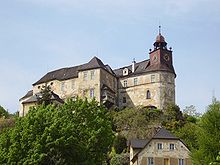Jánský Vrch Castle
The Jánský Vrch Castle (German Johannesberg Castle , also Johannisberg ) in Javorník (German Jauernig) was the summer residence of the Wroclaw bishops until 1945 . It is the only open to the public monuments Location in 2002 resolved Czech jeseník district .
history
The original castle was built in the second half of the 13th century on a strategically important point above Jauernig ( Javorník ). The first written mention comes from 1307, when Duke Bolko I von Schweidnitz was mentioned as the owner. In 1348 the castle was sold by Bolko II von Schweidnitz to the Breslau bishop Preczlaw von Pogarell and thus became part of the episcopal principality of Neisse .
In 1428 the castle was badly damaged by the Hussites and conquered. Bishop Konrad von Oels bought it back in 1432 for a large sum. Further destruction was caused by the demolition of the defense system, with which the bishop wanted to prevent the castle from being re-conquered and from becoming the seat of enemy forces.
Under Bishop Johann IV. Roth the conversion of the castle into a renaissance castle began . However , it was named Johannesberg ( Jánský Vrch ) from its successor, Bishop Johannes V. Thurzo , who completed the renovation and documented this on two stone tablets in the castle wall made in the workshop of Francesco Fiorentino in Kremsier . In Thurzo's time, the castle became a meeting place for artists and scholars, including the canon of Thorn , Nicolaus Copernicus .
The castle survived the Thirty Years' War undamaged. About the death of the notorious castle captain Johann Tümling, who lived here in the second half of the 17th century, there is a legend that it was the devil himself who threw Tümling against the castle wall.
The conversion to a baroque palace began under Bishop Philipp Gotthard von Schaffgotsch , who after his escape from Prussian captivity in 1766 lived until his death in the palace, which at that time was a meeting place for artists from all over the empire. In 1766 Schaffgotsch appointed the composer , violinist and conductor Carl Ditters von Dittersdorf as his palace chaplain . During his thirty year residency, Ditters composed forty of his comic operas .
Schaffgotsch's successor, Prince-Bishop Joseph Christian Franz zu Hohenlohe-Waldenburg-Bartenstein , completed Johannesberg to its present form and also had an ornamental garden and a landscaped park laid out.
Cardinal Melchior von Diepenbrock was a South German Romantic poet . At the time of Archbishop Heinrich Förster , Eichendorff , one of the most important representatives of Romanticism, lived and wrote here from 1856 to 1857 . As the son of the castle captain, the poet Zedlitz was a frequent guest on Johannesberg.
From 1881 to 1883 the writer and editor of the Frankenstein-Münsterberger Zeitung Friedrich Wilhelm Helle was the Prince Bishop's guest at Johannesberg Palace after the controversial Catholic had left Prussia on pending charges of "insulting Protestantism and Old Catholicism ". The bishop sponsored the work on his main work Jesus Messiah annually with 1500 guilders .
The last residents and administrators of the castle were the cardinals Georg von Kopp and Adolf Bertram , who lived in the castle after the evacuation of Wroclaw until his death on July 6, 1945 and whose bones were reburied in the Wroclaw Cathedral after the political change of 1989 .
In 1948 the property of the domain property of the Diocese of Breslau was confiscated , the direction of which Freiwaldau had its seat at Johannesberg Castle for exactly 200 years.
museum
Many of the castle's rooms have historical paintings and wallpapers.
The late Gothic sculptures of St. Barbara , St. Helena and the Virgin Mary from 1491.
The altar in the palace chapel is the work of Dutch masters from the early 17th century.
The castle has an extensive collection of paintings, musical instruments and other art objects belonging to the Wroclaw bishops.
The centerpiece of the museum is a unique collection of around 2000 tobacco pipes , in which there are particularly artistic objects made of porcelain and sepiolite ( meerschaum ). It is the largest collection of its kind in Central Europe.
literature
- Faustin Ens : The Oppaland, or the Troppauer Kreis, according to its historical, natural history, civil and local characteristics . Volume 4: Descriptions of the principalities of Jägerndorf and Neisse, Austrian Antheils and the Moravian enclaves in the Troppauer district , Vienna 1837, pp. 264–266.
- Karl August Müller: Patriotic images, in a history and description of the old castle festivals and knight castles of Prussia. Glogau 1837, pp. 130-131.
Web links
Individual evidence
- ↑ 1307 probably incorrect, as Bolko I died in 1301.
Coordinates: 50 ° 23 '23 " N , 17 ° 0' 0.4" E


